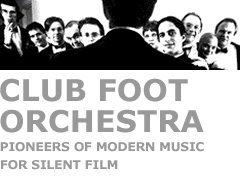 Home
Home Calendar
History
Musicians
Film Collection
Contact Us
richardmarriott.com
THE CABINET OF DR. CALIGARI
The Cabinet of Dr. Caligari (1919) is generally considered the first completely realized German Expressionist film. The screenplay, written by Carl Meyer and Hans Janowitz, combined dream imagery with a STRONG anti-authoritarian message, an outgrowth of their experiences during WWI. Their screenplay had the movie end with Caligari in a straitjacket and raving mad. Fritz Lang, who had been brought in to fix the movie, is responsible for framing the screenplay with footage which suggests that the whole story is a nightmare invented by the patient, who had just been saved by the good doctor. But the fact that the sets remain distorted to the very end, suggest that despite his antiseptic appearance, all is not right with the world.
The Club Foot Orchestra premiered Richard Marriott's score for this film at the Mill Valley Film Festival October 17, 1987. The film sold out San Francisco's Roxie Theatre for seven shows in February 1988 and was subsequently performed at New Music America '89. In 1991 Orchestra performed the score during the Smithsonian Institution's "Exhibit of Degenerate Art", a re-enactment of the 1937 Berlin exhibit of art deemed degenerate by the Nazis. In 1996 the Orchestra performed the score at Lincoln Center.
REVIEWS
"Marriott's writing is nothing less than brilliant." Phil Elwood, San Francisco Examiner
"Marriott's affinity for scoring the film, with a stylistic mix borrowing from German brass bands, cabaret, early jazz and other sources, wedded to the starkly Expressionistic visual imagery of the 1919 "Cabinet", is as near to perfect as any film or music buff could hope for." Larry Kelp, Oakland Tribune
"He has envisioned sound for a make-believe world of someone else's creation. The feeling with which he imbues his score seems to come from inside the film, not something imposed from the exterior, but a scrupulous rendering and extension of the grotesque vision of the original filmmakers." Joel Selvin, San Francisco Chronicle
"One would think Marriott's music would suffer from an excess of split personalities, but he manages to create a cohesive unmistakable "Club Foot" sound. You could call it a "pastiche" or a "collage", but it's more like what anthropologist Claude Levi-Strauss calls "bricolage", an arrangement of already existing elements which, when you organize them differently, take on new properties. Levi-Strauss says that the artist's "universe of instruments is closed and the rules of his game are always to make do with 'whatever is at hand'." This seems to be Marriott's approach... I wouldn't rule out Marriott as the only true conqueror of this "new musical frontier", but his recombinations are innovative and the musical styles he uses assume new meaning in juxtaposition and in contrast with each other." Sarah Cahill, East Bay Express
"Marriott's score is a grand giddy mix of so many genres and tempos that it matches the impressionism and dissonance of the celebrated story of somnambulist murder." Variety
"The Cabinet of Dr Caligari (1919) has had the good fortune to receive what every great silent film deserves: a score worthy of it." Kevin Thomas, Los Angeles Times
"Marriott's score offers the audience a rich and tasty sound that encourages you to expect more than music." Russ Jennings, EAR